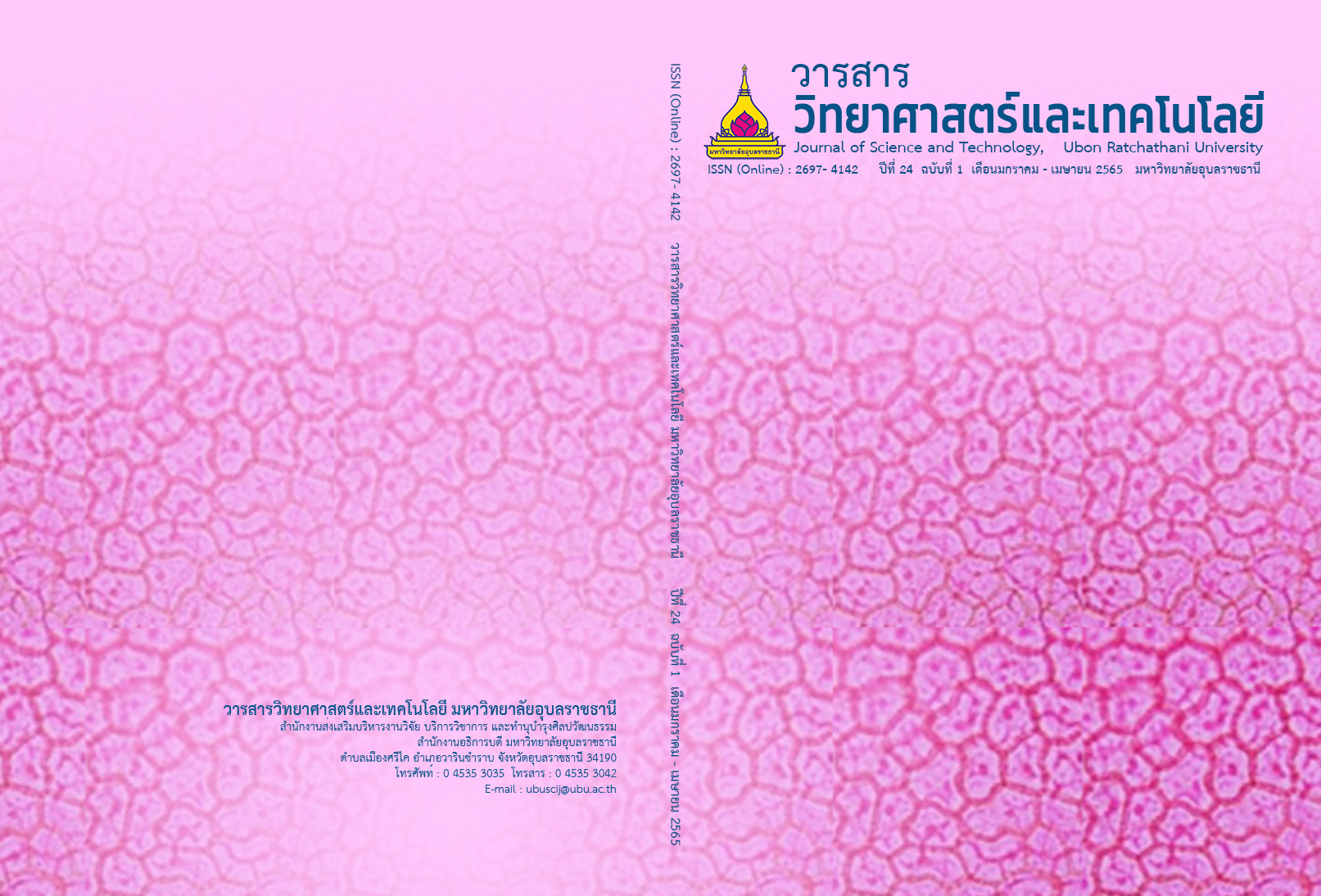การพัฒนาผลิตภัณฑ์แหนมเห็ดเพื่อสุขภาพที่มีส่วนผสมของข้าวเจ้าหลากสี
Main Article Content
บทคัดย่อ
งานวิจัยนี้มีวัตถุประสงค์เพื่อพัฒนาแหนมเห็ดเพื่อสุขภาพ โดยศึกษาอัตราส่วนที่เหมาะสมของเห็ดที่ใช้ในการผลิต 3 ชนิด ได้แก่ เห็ดนางรม เห็ดขอนขาว และเห็ดหูหนู วางแผนการทดลองแบบ Mixture design เพื่อเลือกสูตรแหนมเห็ดที่ให้คุณภาพดีที่สุดและเป็นที่ยอมรับของผู้บริโภค เพิ่มคุณค่าทางโภชนาการด้วยการใช้ข้าวเจ้าหลากสี 4 สายพันธุ์ ได้แก่ ไรส์เบอรี่ หอมนิล มันปูสีชมพู และสังข์หยด ทดแทนข้าวหอมมะลิ 105 พบว่าแหนมเห็ดข้าวไรส์เบอรี่มีปริมาณสารประกอบฟีนอลิคทั้งหมด และความสามารถในการต้านอนุมูลอิสระสูงสุด คือ 672.17 mg GAE/100g และ 1,389.58 mg ascorbic acid/100g ทั้งนี้พบว่าแหนมเห็ดข้าวหอมนิล และแหนมเห็ดข้าวไรส์เบอรี่ให้ค่า EC50 สูงสุด คือ 173.52 และ 154.18 g/ml ตามลำดับ นอกจากนี้ยังพบว่าแหนมเห็ดที่มีส่วนผสมของข้าวไรส์เบอรี่ให้ปริมาณสาร ฟีนอลิค catechin, myricetin, syringic และ P-coumaric สูงที่สุด เท่ากับ 216.15, 136.95, 315.82 และ 370.86 µg/g ตามลำดับ ในขณะที่ข้าวหอมนิลให้ปริมาณฟีนอลิค catechin, myricetin และ P-Coumaric เท่ากับ 194.18, 122.17 และ 373.31 µg/g ตามลำดับ ซึ่งไม่แตกต่างกันอย่างมีนัยสำคัญทางสถิติ (P>0.05) กับข้าวไรส์เบอรี่
Article Details

อนุญาตภายใต้เงื่อนไข Creative Commons Attribution-NonCommercial-NoDerivatives 4.0 International License.
บทความที่ได้รับการตีพิมพ์เป็นลิขสิทธิ์ของ วารสารวิทยาศาสตร์และเทคโนโลยี มหาวิทยาลัยอุบลราชธานี
ข้อความที่ปรากฏในบทความแต่ละเรื่องในวารสารวิชาการเล่มนี้เป็นความคิดเห็นส่วนตัวของผู้เขียนแต่ละท่านไม่เกี่ยวข้องกับมหาวิทยาลัยอุบลราชธานี และคณาจารย์ท่านอื่นๆในมหาวิทยาลัยฯ แต่อย่างใด ความรับผิดชอบองค์ประกอบทั้งหมดของบทความแต่ละเรื่องเป็นของผู้เขียนแต่ละท่าน หากมีความผิดพลาดใดๆ ผู้เขียนแต่ละท่านจะรับผิดชอบบทความของตนเองแต่ผู้เดียว
เอกสารอ้างอิง
Songsanandr, P. and Charoenrat, S. 2016. Product development of fermented pork soft spare ribs for women’s career promotion group, Ton Pao Town Municipality, Sankamphaeng District, Chiang Mai Province. Journal of Community Development and Life Quality. 5(1): 163-173. (in Thai)
Limmatwapiwat, C. and Limmatwapiwat, S. 2009. Medicinal Properties of the Mushroom and White Mouse Ear. http://mis.pharm.su.ac.th/ web/sites/default/files/Jews%20ear%20mushroom. pdf. Accessed 1 September 2021. (in Thai)
Aramsirirujiwet, Y., Nawabut, P. and Suwanarit, P. 2016. Mushrooms extract and their efficiency to inhibit some plant pathogenic fungi and bacteria. Khon Kaen Agriculture Journal. 4(44): 595-604. (in Thai)
Kongkaew, T. and Wattanakosol, A. Profit alternative material: The Manila grass ration of oyster mushroom (Pleurotus ostreatus)cultivated materials. Journal of Science and Technology, Ubon Ratchathani University. 23(2): 74-80. (in thai)
Guer, P., Akata, I. and Kutluer, F. 2009. Antifungal activities of Fomitopsis pinicola (Sw.:Fr) Karst and Lactarius vellereus (Pers.) Fr. Journal of Biotechnology. 8(16): 3811-3813.
Nunboon, J. and et al. 2010. Effect of medicinal plant extracts and edible mushroom extracts in controlling leaf spot disease (Alternaria brassicicola) of cabbage seedling. In: Proceedings of the 8th International Symposiium on Biocontrol and Biotechnology, 4-6 October 2010. Pattaya, Thailand.
Balakumar, R. and et al. 2011. Antibacterial and antifungal activity of fruit bodies of Phellinus mushroom extract. International Journal of Biosciences. 1: 72-77.
Mondal, T., Some, R. and Dutta, S. 2013. Studies on antioxidant and antimicrobial properties of some common. Journal of Today’s Biological Sciences: Research & Review. 1(2): 60-67.
Phongthai, S., Homthawornchoo, W. and Rawdkuen, S. 2017. Preparation, properties and application of rice bran protein: A review. International Food Research Journal. 24(1): 25-34.
Saenjum, C. and et al. 2012. Antioxidant and anti-infammatory activities of gamma-oryzanol rich extracts from Thai purple rice bran. Journal Medical Plants Research. 6: 1070-1077.
Klongpityapong, P and Jaricksakulchai, J. 2019. Development of pharmaceutical preparation from rice bran oil for health promotion. EAU Heritage Journal Science and Technology. 13(2), 1-16. (in Thai)
Chen, M.H., and et al. 2012. Growth-inhibition effects of pigment rice bran extracts and three red bran fractions against human cancer cell: Relationships with composition and antioxidative activities. Journal of Agricultural and Food Chemistry. 60(36): 9151-9161.
Goodyear, A. and et al. 2015. Dietary rice bran supplementation prevents Salmonella colonization differentially across varieties and by priming intestinal immunity. Journal of Functional Foods. 18: 653-664.
Alrahmany, R., Avis, T.J. and Tsopmo, A. 2013. Treatment of oat bran with carbohydrases increases soluble phenolic acid content and influences antioxidant and antimicrobial activities. Journal of Food Research International. 52(2): 568–574.
Nam, S.H. and et al. 2005. Antioxidative, antimutagenic, and anticarcinogenic activities of rice bran extracts in chemical and cell assays. Journal of Agricultural and Food Chemistry. 53(3): 816-822.
Liu, L. and et al. 2017. Complex enzyme hydrolysis releases antioxidative phenolics from rice bran. Journal of Food Chemistry. 214: 1-8.
Kim, S.M. and Lim, S.T. 2016. Enhanced antioxidant activity of rice bran extract by carbohydrase treatment. Journal of Cereal Science. 68: 116-121.
Fabian, C. and Ju, Y.H. 2011. A review on rice bran protein: its properties and extraction methods. Journal of Critical Reviews in Food Science and Nutrition. 51(9): 816-827.
Amagliani, L. and et al. 2017. Composition and protein profile analysis of rice protein ingredients. Journal of Food Composition and Analysis. 59: 18-26.
Wang, M. and et al. 1999. Preparation and functional properties of rice bran protein isolate. Journal of Food Chemistry. 47(2): 411-416.
Thamnarathip, P. and et al. 2016. Identification of peptide molecular weight from rice bran protein hydrolysate with high antioxidant activity. Journal of Cereal Science. 69: 329-335.
Phongthai, S. and et al. 2018. Fractionation and antioxidant properties of rice bran protein hydrolysates stimulated by in vitro gastrointestinal digestion. Journal of Food Chemistry. 240: 156–164.
Kaewjumpol, G. and et al. 2018. The production of hydrolysates from industrially defatted rice bran and its surface image changes during extraction. Journal of The Science of Food and Agriculture. 98(9): 3290-3298.
AOAC. 2000. Official Method of Analysis of AOAC International. 17th edition, the Association Official Analytical Chemists. Gaithersburg, MD: AOAC International.
Praditsrigul, N. and et al. 2016. The product development of fermented grey oyster mushroom (Pleurotus sajorcaju). In: Proceedings of the 1st National Academic Conference of Rajamangala University of Technology Suvarnabhumi, 22 June 2016. Bangkok, Thailand. (in Thai)
Tangsombatvichit, P., Khuenson, N. and Matthayom, W. 2022. The nutritional value and antrioxidant activities of the developed Thai fermented Bhutan oyster mushroom (Pleur eous). Naresuan University Journal: Science and Technology. 30(1): 120-129. (in Thai)
Siphaya, C. and Phiwsaoas, J. 2015. Library and Science and Technology Information Center. http://lib3.dss.go.th/fulltext/dss_knowledge/bsti_11_2558_Riceberry.pdf. Accessed 20 March 2017.
Wiriyacharee, P., Rujanakraikarn, L., and Kuntiya, A. 1993. Nham Product Development Using Mixed Bacterial Starter Cultures 3. Suitable Spices Formulation for Nham Production. https://agris.fao.org/agris-search/search.do?record ID=TH2001003443. Accessed 5 September 2021.
Sueaman, K. and et al. 2019. Determination of antioxidant capacity of Rice berry and Khao Dok Mali 105 cultivars. PSRU Journal of Science and Technology. 4(3): 95-108. (in Thai)
Sultana, B. and et al. 2012. Effect of drying techniques on the total phenolic contents and antioxidant activity of selected fruits. Journal of Medicinal Plants Research. 6(1): 161-167.
Visessanguan, W., Benjakul, S. and Tapingkae, W. 2006. Changes in lipid composition and fatty acid profile of Nham, a Thai femented pork sausage, during fermentation. Journal of Food Chemistry. 94(4): 580-588.


